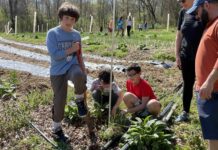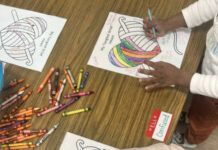At Baltimore Hebrew Congregation, Cantor Ann Sacks has noticed an uptick in the number of adults enrolling in her classes on biblical and prayerbook Hebrew.
Before the pandemic, Sacks would normally have seen three or four students enrolled in a single class on Sundays, though that number does vary. Currently, Sacks has six or seven students.
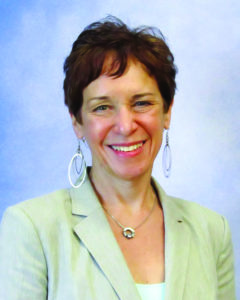
“It’s not huge numbers of people,” Sacks said, “but the consistency with which they come to the class is greater, and they’re not dropping out.”
This uptick is not unique. Many have been spending their time in extended quarantine working on self improvement and the acquisition of new skills.
One of Sacks’ students, Saul Lindenbaum of Baldwin, became interested in Hebrew lessons in 2019, after Sacks helped him prepare for a sort of redo of his bar mitzvah ceremony around the time of his 80th birthday.
Afterward, with a new appetite to learn the language, Lindenbaum began by taking Sacks’ course on prayerbook Hebrew in July of 2020, and is currently enrolled in her course on biblical Hebrew. On Tuesdays at 1:30 pm, Lindenbaum and his classmates spend the one-hour course going over nouns, verb tenses, direct objects and word pairs, he said. Class exercises involve a great deal of translating, and Lindenbaum has been doing the homework assignments every day in order to keep up with the lessons.
Lindenbaum, who holds a doctorate in clinical psychology, considers himself rather proficient with languages, noting how he studied Spanish, French and German during high school and college and that he took classes in Italian several years ago. Despite this, he has found Hebrew to be a particularly tricky language to master. “It is a hard language,” Lindenbaum said, “Prefixes, suffixes, subtle changes … this is much more difficult.”
Much of the added challenge stems from Hebrew’s use of a different alphabet, Lindenbaum said. “I seem to remember by visualizing things,” he said. “And because I’m not that familiar with looking at Hebrew a lot, I have trouble visualizing the words.”
Lindenbaum’s participation in the Hebrew prayerbook course gave him a greater understanding of what was being spoken when he attended religious services, he said. When he learned of Sacks’ biblical Hebrew course, he felt enthusiastic about the possibilities that could bring as well. “I thought ‘Well, that would really be terrific,’” Lindenbaum said, “‘to be able to read right from the Bible, and to be able to understand.’”
Another student in Sacks’ biblical Hebrew course, Lenore Meyers of Pikesville, considers herself an “advanced beginner” at modern Hebrew. She signed up for the class after seeing it pop up in BHC’s weekly emails.
“I knew that [biblical Hebrew] was different in many ways than modern Hebrew, so I was curious about that,” Meyers said, “and I thought, ‘You know, I’ll learn something,’ and my goal was to learn what I could learn, as well as specifically understand what I was following along with in the Chumash better.”
For Meyers, taking the class helped her to answer grammatical questions that she had been wondering about for decades, which arose from discrepancies she noticed during religious services between Hebrew text and its English translation.
“There were grammatical things that never made sense to me,” Meyers said. “I saw the English, I saw the Hebrew and I’m like, ‘Why did they say it this way?’ And ‘Why is the Hebrew in this form?’”
This began to change soon after the course got started. “Almost from the beginning, when this book started explaining grammar, it was like every week a lightbulb goes off,” Meyers said. “Like ‘Oh, now I get it’ … Now I know why it’s ‘Yom Kippur’ instead of ‘Yom Shel Kippur.’”
While some work on improving their linguistic skills, others, such as Amy Chmar, focus on more hands-on talents. A resident of Pikesville and member of Chizuk Amuno Congregation, Chmar has spent much of the pandemic learning machine sewing.
Chmar’s daughter received a sewing machine for her 9th birthday that had mostly sat idle except when Chmar herself would occasionally try it out a few times a year, she said.
In April 2020, Chmar started taking classes at Pikesville’s Sewfabulous Sewing School. The owner, Margaret Garland, has been providing online classes, which Chmar has been taking weekly for the past year. Some of the projects she’s worked on have included pajama pants, a skirt, a dress and a pair of pants.
“When I go to [Broadway] shows, I love seeing the costuming, and that’s always fascinated me,” Chmar said. “It’s always the creativity of taking a piece of fabric and just turning it into something that helps to tell a story.”
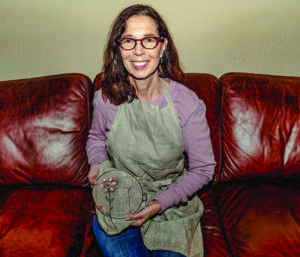
Caplan wearing an embroidered apron (Courtesy of Amy Caplan)
While Chmar has focused on sewing fabrics together, Amy Caplan of Owings Mills has concentrated on embroidering them. A retired physician and member of Beth Tfiloh Congregation, Caplan said that, when she was young, her mother had encouraged her to try a bit of embroidery and other needlework activities, but it never quite stuck.
In May, when it became clear that the pandemic wasn’t going anywhere anytime soon, Caplan started looking for something she could do while the television was on. She turned to embroidery books, kits and online videos and began learning the finer points of the skill.
Caplan said she was drawn to the creativity of embroidery, which offers different stitches and colors to choose from. She also saw it as a form of instant gratification, in that embroidery could be done relatively quickly.
“I like embroidery [because] it’s a little more free-form,” Caplan said. “You have more choices. And it’s an opportunity to learn a lot of new stitches and challenge myself, which I enjoyed.
“It’s almost like painting with thread,” Caplan said.
Caplan has embroidered an apron, pillow cases and a “sampler,” a traditional embroidery project to do when first learning needlework.
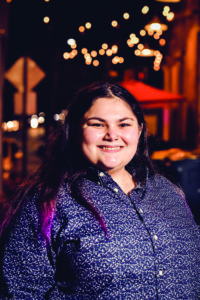
Stacy Jarvis, an Israel education associate at the Macks Center for Jewish Education, has spent much of her pandemic downtime practicing knitting.
Prior to the pandemic, Jarvis had essentially zero experience with knitting and had not held much interest in it.
“I had only ever seen my roommate knit, and I had no idea how it worked,” Jarvis said. “I had no interest in learning how to knit, but during the pandemic, things got really boring.”
Jarvis’ roommate suggested she take up the pastime and offered to teach her.
Jarvis decided to try it out as the fall of 2020 turned to winter. She found it an effective way to stave off boredom, she said. While Jarvis’ roommate was her principal tutor in the skill, from time to time Jarvis also turned to YouTube videos for instruction.
Jarvis currently views herself as a “novice knitter,” and is currently working on knitting a hat, though she has so far primarily focused on knitting scarves, she said. She enjoys giving her completed crafts away to other people, including one scarf she gave to her mother that has since been claimed by her mother’s cat.
“It can be seen as an old person thing,” Jarvis said of knitting, “but it’s pretty calming, and it’s a nice way to cope with boredom, and it’s fun because you’re also creating something that you can utilize after you’re done.”
To those with an interest in learning to knit, Jarvis’ message was to “just go for it. I know that a lot of people are bored right now, and so I think if you’re thinking about doing something, just do it.
“You won’t know until you try,” Jarvis added.


